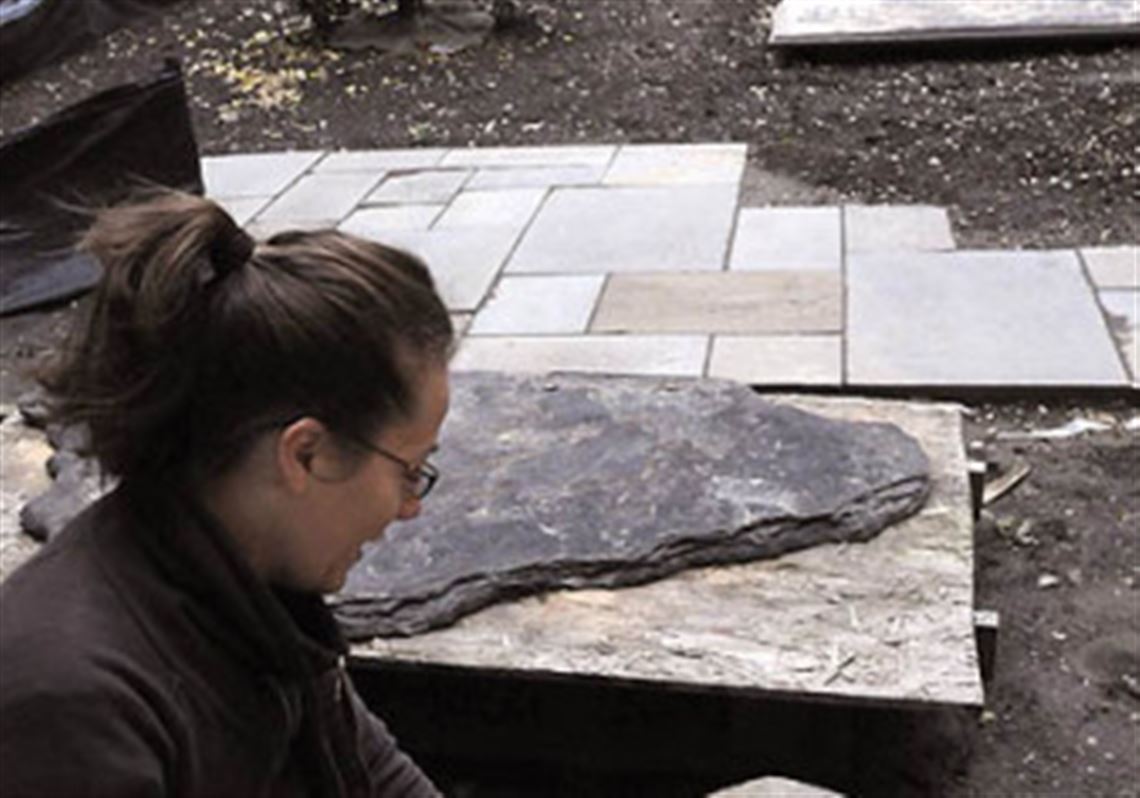Even after 214 years, long since all record of who she was has vanished, the ache of grief lingers in the beauty of a gravestone carved for a little girl named Sarah Ransom.
The perfectly preserved sandstone marker looks like a child's sarcophagus, and it is etched with the girl's name and the year that may be that of both her birth and her death: 1794.
"That was quite an exquisite stone for a baby," said Teresa Duff, project manager for the University of Pennsylvania's Architectural Conservation Laboratory grave marker project at Trinity Episcopal Cathedral, Downtown.
The marker, buried until a landscaper bumped into it two weeks ago, "has been one of the greater finds of this project," Ms. Duff said.
The small graveyard between the cathedral and neighboring First Presbyterian Church, and a strip of graves between the cathedral and the Oliver Building, are all that remain of a cemetery that once filled a city block. Because it was above flood level, it was a burial ground for Indians and the French long before the British seized Fort Pitt in 1758.
About 2,000 Christian burials have been documented on that block, though most of the bodies were removed for later construction. About 150 markers remain, some marking family plots with many graves. The site was officially closed to new burials in 1868 because it was full.
Ms. Duff has guided the final phase of an 18-year project to document the burial ground and repair its crumbling markers. Landscape architects who specialize in historic spaces are restoring the green space with native flowering trees.
"The ultimate goal is to have the public come back and use this space to relax and reflect," Ms. Duff said.
The project has turned up stones and stone fragments that had long been buried and for whom no records exist. It's unclear whether the bodies they marked remain beneath the ground, since most were moved to other sites long ago.
Other than the accidental discovery of several vaults whose lids were near the surface, workers never dug deep enough to reach human remains.
"At the most we went down 1 or 2 feet. The bodies are much lower than that, and we did not disturb them," said the Rev. Catherine Brall, canon of the cathedral.
A widely circulated estimate says that block of Sixth Avenue once held 4,000 graves. But Lynne Wohleber, archivist for the Episcopal Diocese of Pittsburgh, says that's a guesstimate and doesn't give it much weight.
In the 1980s, genealogist Helen Harris combed an array of church, estate and other records to document about 2,000 burials from 1762 to 1868.
But incomplete records have been a problem. People were buried and removed, with no record of transfer. Some, like little Sarah Ransom, had no record at all.
The earliest documented burial is that of Capt. Richard Mather of the Royal American Regiment in March 1762, but no stone with his name has been identified. The oldest legible stone is that of Capt. Samuel Dawson of the 8th Pennsylvania Regiment of Foot Soldiers, who died Sept. 6, 1779.
Some of Pittsburgh's most notable white settlers remain buried there. But the most famous grave belongs to a Shawnee Indian chief known as Red Pole.
In 1796, he traveled from Ohio to Philadelphia to sign a peace treaty with President George Washington. He was on his way home by boat when ice jams stopped him at Pittsburgh. After he fell ill here and died on Jan. 28, 1797, orders were given for him to be buried with full military honors.
The Rev. George Werner, who retired in 1999 after 20 years as the cathedral dean, says his favorite stone was for a young man known only for having died a week before he was to have been married. William Edward Muller was 23 when he was thrown from his horse, breaking his leg. A long epitaph recounts the sad story, concluding, "the lapse of seven days closed the scene and compelled him to resign the promised festivities of the bridal for the awful stillness of the tomb."
Even before the burial ground was closed in 1868, families had been moving bodies to places with more room. Allegheny Cemetery in Lawrenceville records nine transfers from Trinity in 1863. But it has no record of the far larger number it received from 1900 to 1908 to make way for the Oliver Building.
Adding to the confusion is the fact that some monuments remained after the bodies were moved. Felix Bruno, a French hero of the American Revolution who died here in 1838, had a family plot at Trinity.
"All of the Brunos were removed to Allegheny Cemetery, but their marker is still there because of the historical significance," Ms. Wohleber said.
By the 1980s, when Trinity member Dorothy Amis again inventoried the graveyard, many slabs were below ground and church leaders believed the graves were sinking. But in 1990 the first experts from the University of Pennsylvania found that the stones were being buried by polluted dust, which formed an oily layer a foot deep. It was removed a decade ago.
Twenty years ago Ms. Amis thought she had good records.
"But when this latest restoration crew came along, the landscapers found several crypts that we did not know about," she said.
Ms. Duff believes the newly discovered vaults -- the largest of which was 8 feet by 12 feet -- held unclaimed remains from the Oliver relocation 100 years ago.
"It was a brick cavity in the ground, containing wooden coffins and human remains," she said.
Everything was documented, new concrete lids were made for the vaults and the remains were sealed back inside them.
"The church was adamant about respecting the resting place of these people," she said.
To Ms. Duff, the markers have a life of their own. A slight young woman who stands 5 feet 2 inches, she is a foot shorter than the typical marker, which outweighs her by 700 pounds. To move them around her triage center for stones, she rigged a series of hoists and pulleys.
Most are made of sandstone and have crumbled. For those markers with legible information remaining, Ms. Duff and her interns have carefully collected the fragments and pieced them back together using epoxy.
"It's the ultimate jigsaw puzzle," she said.
A new plaque will mark the grave of those whose stones were removed, and the eroded stones will be buried in the plot.
"If we put it back out there, I think it would be a disservice to the stone. It has had its life and served the purpose for which it was made," Ms. Duff said.
First Published: May 26, 2008, 8:00 a.m.

















